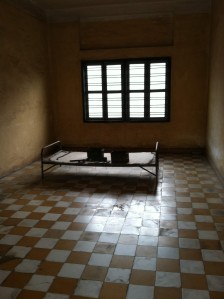Cambodia is still recovering from the devastating effects of the Khmer Rouge, followers of the ruling party, the Communist Party of Kampuchea. They ruled the country between 1975 and 1979 and in those four years, annihilated over 3 million people, in a country of less than 8 million. That is close to one half of the population.
Under the leadership of Pol Pot, the Khmer Rouge sought to create an agrarian-based Communist society. It forced everyone out of the cities and into the fields. Phnom Penh, Siem Reap, all the major cities were turned into ghost towns. The Khmer Rouge wanted to eliminate anyone suspected of “capitalist” ideas or activities. This included professionals and almost everyone with an education, many urban dwellers, and people with connections to foreign governments.
Although the genocide refers to those years between 1975 and 1979, when the Khmer Rouge were in power, Pol Pot and his followers were active long after their deposal in ’79. They even retained their seat at the U.N. until 1993.
Mass graves dating from the Khmer Rouge era are found throughout Cambodia. In Phnom Penh, I visited the Tuol Sleng Museum, which is the old Tuol Svay Prey High School that was taken over in 1975 by Pol Pot’s security forces, and turned into a prison, known as Security Prison 21 (S-21).
According to my guide book, detainees who died during torture were buried in mass graves inside the prison grounds. During the first part of 1977, S-21 averaged 100 victims per day.
A cell from S-21:
The gallows, in the S-21 courtyard:
Rules to live by at S-21:
Almost all of the people held at S-21 were later taken to the extermination camp at Choeung Ek, southwest of Phnom Penh, and were executed. They comprised only a portion of the 20,000 people who lost their lives at these Killing Fields.
I went here one afternoon with a group of British guys from my hostel. The audio guide was fantastic and took us through the grounds (it was chilling how many “areas” of the killing fields were dedicated for specific tasks – see pic below) and really explained the history of the Khmer Rouge. The audio guide took about one hour, during which the clouds above turned black and it thundered several times. Quite a combo.
Fragments of human bone and bits of cloth are scattered around the disinterred pits (mass graves) and more than 8,000 skulls are stacked and visible through the glass panels of the Memorial Stupa (made in 1988) at the center of the grounds.
Killing tree against which executioners beat children:
Children playing outside the fields:
Although the Cambodians I met were a friendly people, the horror of the Khmer Rouge years has definitely left the country in shock. Everyone was affected to some extent, either losing parents, seeing their siblings killed. Very few people talk about Pol Pot and his regime, though one guesthouse manager did speak to me about it. She was 3 when he came to power, and recalls fleeing to the border with Thailand, and the emotions she and her parents felt for years after losing brothers, aunts, uncles, cousins…It will take generations to heal. Unfortunately, similar things still happen today in places like Darfur and Pakistan. It may be naive, but the idealist in me hopes that more people visit Cambodia and learn about its past so we can stop and prevent these horrors.






I’m loving your educational and entertaining reports. Keep ’em coming!
Jen
I’m with Jen! So enjoying your trip….alongside you virtually.
La solution : un gouvernement planetaire, mais l’humanite est a des annees lumiere de ca…
Finally caught up with your posts! Enjoyed reading them and hope you get a chance to update soon!
Thanks for your comments! A lot more entries to come!